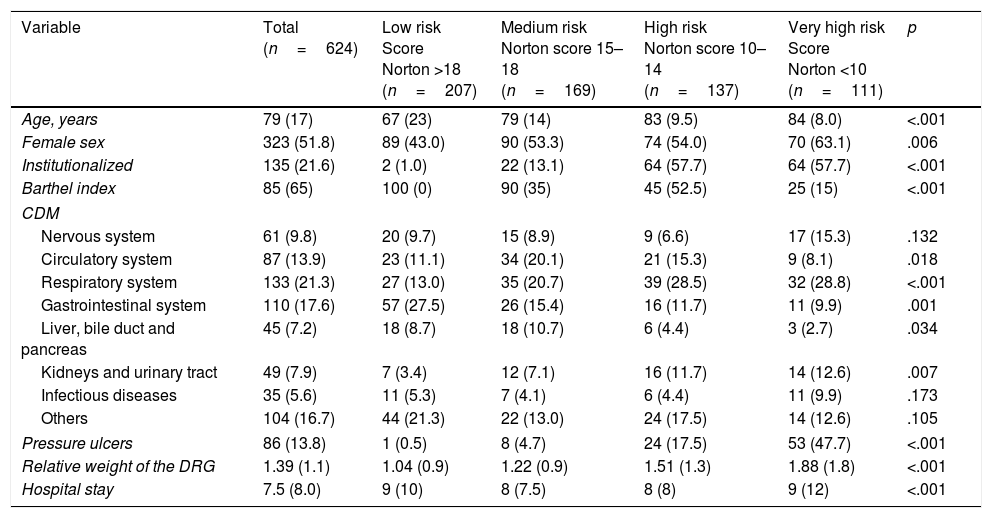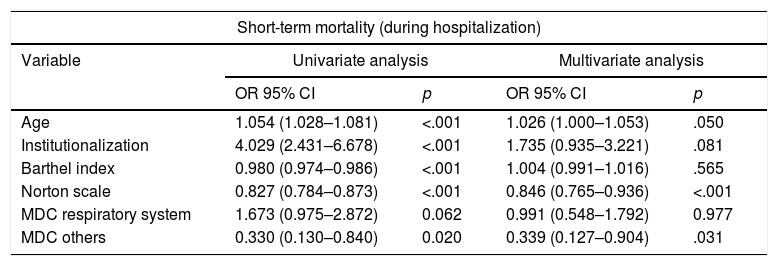To determine the association between the Norton scale score (which assesses the risk of pressure ulcers) and mortality in the short, medium and long term in patients hospitalised in internal medicine departments.
Patients and methodsA prospective, single-center cohort study was conducted on patients hospitalised in the months of October 2010 and January, May and October 2011. Data was collected on age, sex, Barthel index, Norton scale, presence of pressure ulcers, major diagnostic category, hospital stay and weight of the diagnosis-related group. The patients were divided according to the risk categories of the Norton scale. The follow-up was 3 years.
ResultsThe study included 624 patients with a median age (interquartile range) of 79 (17) years and a median Norton scale score of 16 (7). During hospitalization, 74 (11.9%) patients died, 176 (28.2%) died at 6 months, 212 (34.0%) died at 1 year, and 296 (47.4%) died at 3 years. Mortality was greater in the higher risk categories of the Norton scale. The Norton score was independently associated with mortality at 6 months (p<.001), at 1 year (p=.005), and at 3 years (p=.002). The areas under the curve of the Norton scale were 0.746 (95% CI 0.686–0.806), 0.735 (95% CI 0.691–0.780) and 0.751 (95% CI 0.713–0.789), respectively (p<.001).
ConclusionsThe Norton scale is useful for predicting the prognosis in the short, medium and long term in patients hospitalized in internal medicine departments.
Determinar la asociación entre la puntuación de la escala de Norton (que valora el riesgo de padecer úlceras por presión) y la mortalidad a corto, medio y largo plazo en los pacientes hospitalizados en Medicina Interna.
Pacientes y métodosEstudio de cohortes prospectivo, unicéntrico, de pacientes ingresados en los meses de octubre de 2010, y enero, mayo y octubre de 2011. Se recogieron la edad, sexo, índice de Barthel, escala de Norton, presencia de úlceras por presión, categoría diagnóstica mayor, estancia hospitalaria y peso del grupo relacionado de diagnóstico. Se dividió a los pacientes según las categorías de riesgo de la escala de Norton. El seguimiento fue de 3 años.
ResultadosSe incluyeron 624 pacientes con una edad mediana (rango intercuartílico) de 79 (17) años y una puntuación mediana en la escala de Norton de 16 (7). Durante el ingreso fallecieron 74 (11,9%) pacientes, a los 6 meses 176 (28,2%), al año 212 (34,0%), y a los 3 años 296 (47,4%). La mortalidad fue mayor en las categorías de más riesgo en la escala de Norton. La puntuación en la escala de Norton se asoció de forma independiente con la mortalidad a los 6 meses (p<0,001), al año (p=0,005), y 3 años (p=0,002). Las áreas bajo la curva de la escala de Norton fueron 0,746 (IC95% 0,686-0,806), 0,735 (IC95% 0,691-0,780) y 0,751 (IC95% 0,713-0,789), respectivamente (p<0,001).
ConclusionesLa escala de Norton es útil para predecir el pronóstico a corto, medio y largo plazo en pacientes ingresados en Medicina Interna.
Article
Diríjase desde aquí a la web de la >>>FESEMI<<< e inicie sesión mediante el formulario que se encuentra en la barra superior, pulsando sobre el candado.

Una vez autentificado, en la misma web de FESEMI, en el menú superior, elija la opción deseada.

>>>FESEMI<<<













